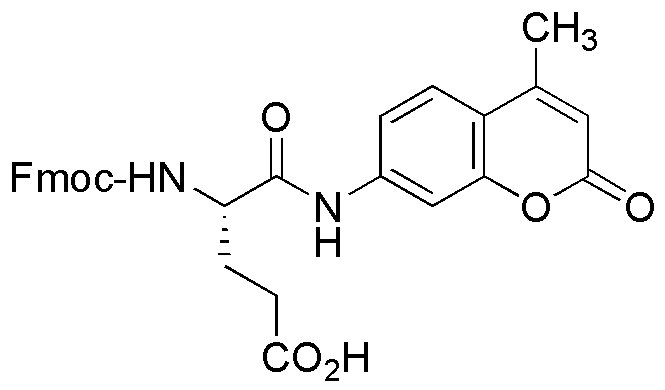Fmoc-L-glutamic acid a-7-amido-4-methylcoumarin is widely utilized in research focused on:
- Peptide Synthesis: This compound serves as a key building block in the synthesis of peptides, particularly in solid-phase peptide synthesis, allowing for the creation of complex peptide sequences with high purity.
- Fluorescent Probes: Its unique structure enables its use as a fluorescent probe in biochemical assays, helping researchers visualize and track biological processes in real-time.
- Drug Development: The compound is explored in medicinal chemistry for the development of new drugs, particularly those targeting specific proteins, due to its ability to modify biological activity.
- Bioconjugation: It is applied in bioconjugation techniques, linking biomolecules to enhance their stability and efficacy, which is crucial in therapeutic applications.
- Research in Neuroscience: The compound is utilized in studies related to neurotransmitter signaling, aiding in the understanding of neurological pathways and potential treatments for neurodegenerative diseases.
General Information
Properties
Safety and Regulations
Applications
Fmoc-L-glutamic acid a-7-amido-4-methylcoumarin is widely utilized in research focused on:
- Peptide Synthesis: This compound serves as a key building block in the synthesis of peptides, particularly in solid-phase peptide synthesis, allowing for the creation of complex peptide sequences with high purity.
- Fluorescent Probes: Its unique structure enables its use as a fluorescent probe in biochemical assays, helping researchers visualize and track biological processes in real-time.
- Drug Development: The compound is explored in medicinal chemistry for the development of new drugs, particularly those targeting specific proteins, due to its ability to modify biological activity.
- Bioconjugation: It is applied in bioconjugation techniques, linking biomolecules to enhance their stability and efficacy, which is crucial in therapeutic applications.
- Research in Neuroscience: The compound is utilized in studies related to neurotransmitter signaling, aiding in the understanding of neurological pathways and potential treatments for neurodegenerative diseases.
Documents
Safety Data Sheets (SDS)
The SDS provides comprehensive safety information on handling, storage, and disposal of the product.
Product Specification (PS)
The PS provides a comprehensive breakdown of the product’s properties, including chemical composition, physical state, purity, and storage requirements. It also details acceptable quality ranges and the product's intended applications.
Certificates of Analysis (COA)
Search for Certificates of Analysis (COA) by entering the products Lot Number. Lot and Batch Numbers can be found on a product’s label following the words ‘Lot’ or ‘Batch’.
Numéro de catalogue
Numéro de lot/série
Certificates Of Origin (COO)
This COO confirms the country where the product was manufactured, and also details the materials and components used in it and whether it is derived from natural, synthetic, or other specific sources. This certificate may be required for customs, trade, and regulatory compliance.
Numéro de catalogue
Numéro de lot/série
Safety Data Sheets (SDS)
The SDS provides comprehensive safety information on handling, storage, and disposal of the product.
DownloadProduct Specification (PS)
The PS provides a comprehensive breakdown of the product’s properties, including chemical composition, physical state, purity, and storage requirements. It also details acceptable quality ranges and the product's intended applications.
DownloadCertificates of Analysis (COA)
Search for Certificates of Analysis (COA) by entering the products Lot Number. Lot and Batch Numbers can be found on a product’s label following the words ‘Lot’ or ‘Batch’.
Numéro de catalogue
Numéro de lot/série
Certificates Of Origin (COO)
This COO confirms the country where the product was manufactured, and also details the materials and components used in it and whether it is derived from natural, synthetic, or other specific sources. This certificate may be required for customs, trade, and regulatory compliance.


